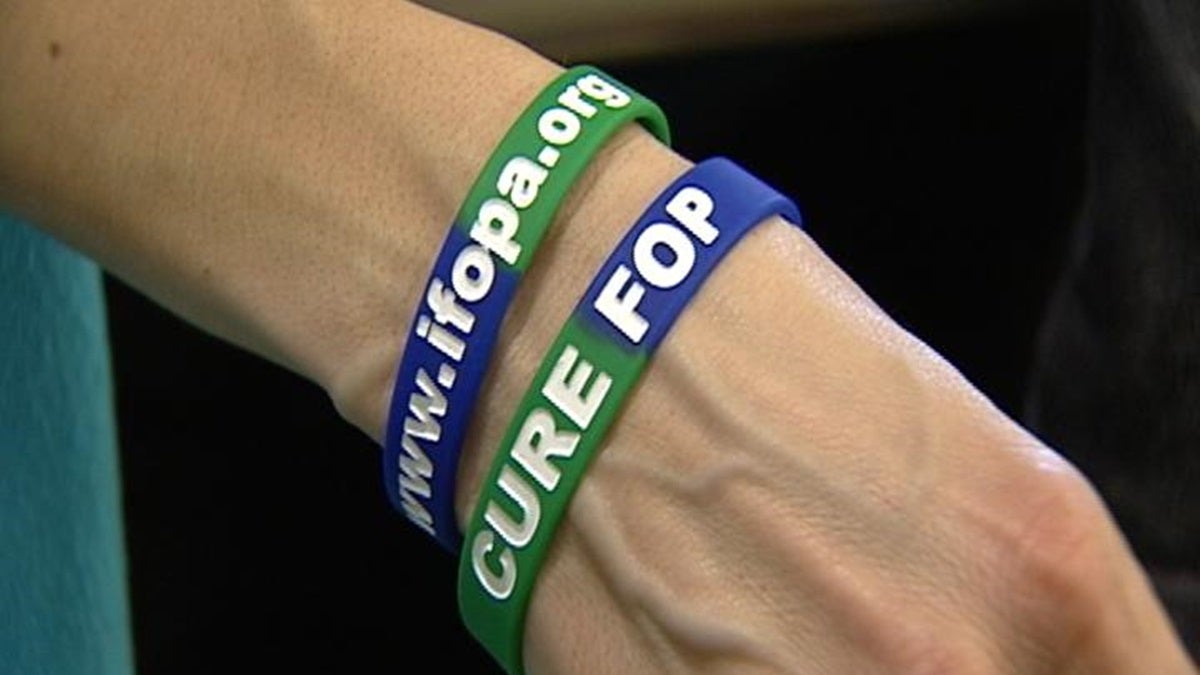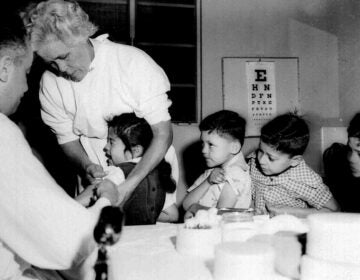Delaware boy fights extremely rare genetic disease

(Gene Ashley/WHYY)
Justin Henke is more than one-in-a-million kid. He’s a one-in-two-million kid, which are the odds of the rare genetic condition Justin suffers from.
It’s known as FOP, an abbreviation of Fibrodysplasia Ossificans Progressiva. The disabling genetic disease can cause muscles, tendons, ligaments and connective tissues to turn into bone. Bridges of extra bone develop over joints and form a second skeleton that straitjackets the body and restricts movement.
Flare-ups in FOP patients can occur spontaneously, but injuries or trauma can accelerate the effects. Vaccinations, even dental work, are considered dangerous.
Knowing all of this, Justin takes extra care to protect himself from injury.
“If I get a bad bruise, I could lock up like my elbow and I can’t move it,” Justin said. “I can’t take contact, like rough contact. I can do handshakes and everything.”
Justin, 14, is a resident of Middletown, Del. He was born with his neck vertebrae fused, extra bone in his hips and elbows and malformed big toes. During the first six years of his life, Justin’s mother Wendy said she suspected her son suffered from an ailment, but was unsure of the exact diagnosis.
“And then one night, it was actually Sunday night, April 23, 2006, I was just reading news online and I saw a … news article that said, ‘gene discovered for rare stone man’s disease,'” she recalled. “Now at that time I wasn’t looking for Justin, I just out of curiosity sake I clicked on it and as I read through it, I got chills.”
Wendy said the article could have been written about Justin, but what drove it home for her were pictures of an FOP patient’s feet that closely resembled Justin’s.
“It said, all FOP patients, at birth, share a characteristic malformation of the great toe,” Wendy said.
According to the International FOP Assocation, 95 percent of those with the disease exhibit the toe abnormality. The disease is also often misdiagnosed as cancer, but any surgeries or biopsies can worsen the condition because of the trauma they cause.
Finding a cure and treatment
The only lab dedicated to FOP research is at the University of Pennsylvania in Philadelphia. Researchers at the lab discovered the FOP gene in 2006. The lab’s annual budget is $1.5 million, with over $500,000 of it coming from fundraisers and donations raised by the IFOPA.
Wendy said FOP is the spontaneous misspelling of one letter in the genetic code. The disease is not the result of parents passing on a recessive gene to their children.
While there is still no effective treatment or cure to date, Wendy talked about the discovery of a possible drug treatment that could delay the effects of the disease.
“It interrupts what’s called the scaffolding phase of a flare-up, so when that tissue is laying down scaffolding, cartilage scaffolding for bone to grow on, [researchers] have a drug that interrupts that scaffolding phase,” said Wendy.
She noted it could be years before the drug is available.
Holding pattern
Fortunately, Justin’s disease has not progressed.
“He’s grown big and I guess that’s what’s really important is the fact that his chest has been able to grow,” she said. “Because with FOP, extra bone grows about the rib cage and it restricts the expansion and contraction of the rib cage for breathing.”
Likening FOP to a sleeping giant, Wendy is well aware that everything could change overnight. However, she’s hoping that a cure is discovered before that giant awakens in her son.
“You go on living, but you know that you’ve got a beast that potentially could just arrive on the scene,” she said. “You could wake up and a joint that once moves, no longer moves.”
WHYY is your source for fact-based, in-depth journalism and information. As a nonprofit organization, we rely on financial support from readers like you. Please give today.





